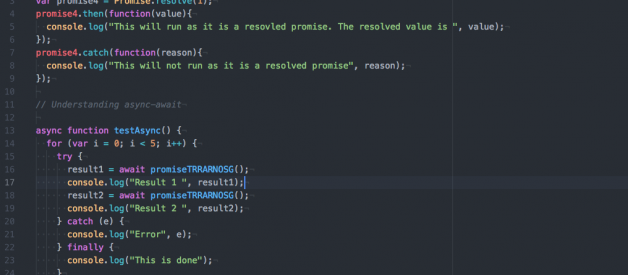A set of rules for when to use which

I recently read a medium post where the author claimed that using async-await is better than using promises.
While this might be true in general cases, I think that generalisation is too broad and doesn?t do justice to either async-await or promises.
For someone new to JavaScript, making sense of these and deciding which one to use can be a challenge. In this post, I will list things that I have learned about these and how I decide when to use which.
I read somewhere that async-await is syntactical sugar for using promises. So, before getting to know async-await or deciding which approach to use, make sure that you have a good understanding of promises and async-await.
Here are some thumb rules that I follow.
Thumb Rules for Using Promises

- Use promises whenever you are using asynchronous or blocking code.
- resolve maps to then and reject maps to catch for all practical purposes.
- Make sure to write both .catch and .then methods for all the promises.
- If something needs to be done in both cases use .finally.
- We only get one shot at mutating each promise.
- We can add multiple handlers to a single promise.
- The return type of all the methods in the Promise object, regardless of whether they are static methods or prototype methods, is again a Promise.
- In Promise.all, the order of the promises are maintained in the values variable, irrespective of which promise was first resolved.
Once you have wrapped your head around promises, check out async-await. It helps you to write code that is much more readable. When it is not used properly, it has its downsides.
Thumb Rules for async-await
Here?s a list of thumb rules that I use to stay sane while using async and await.
- async functions return a promise.
- async functions use an implicit Promise to return results. Even if you don?t return a promise explicitly, the async function makes sure that your code is passed through a promise.
- await blocks the code execution within the async function, of which it (await statement) is a part.
- There can be multiple await statements within a single async function.
- When using async await, make sure you use try catch for error handling.
- Be extra careful when using await within loops and iterators. You might fall into the trap of writing sequentially-executing code when it could have been easily done in parallel.
- await is always for a single Promise.
- Promise creation starts the execution of asynchronous functionality.
- await only blocks the code execution within the async function. It only makes sure that the next line is executed when the promise resolves. So, if an asynchronous activity has already started, await will not have any effect on it.
Should I Use Promises or async-await
The answer is that we will use both.
Here are the thumb rules that I use to decide when to use promises and when to use async-await.
- The async function returns a promise. The converse is also true. Every function that returns a promise can be considered as async function.
- await is used for calling an async function and waits for it to resolve or reject.
- await blocks the execution of the code within the async function in which it is located.
- If the output of function2 is dependent on the output of function1, I use await.
- If two functions can be run in parallel, create two different async functions and then run them in parallel.
- To run promises in parallel, create an array of promises and then use Promise.all(promisesArray).
- Every time you use await remember that you are writing blocking code. Over time we tend to neglect this.
- Instead of creating huge async functions with many await asyncFunction() in it, it is better to create smaller async functions. This way, we will be aware of not writing too much blocking code.
- Another advantage of using smaller async functions is that you force yourself to think of which async functions can be run in parallel.
- If your code contains blocking code, it is better to make it an async function. By doing this, you are making sure that somebody else can use your function asynchronously.
- By making async functions out of blocking code, you are enabling the user (who will call your function) to decide on the level of asynchronicity they want.
I hope this helps you decide when to use promises and when to use async-await.
You can subscribe to my newsletter https://understandingx.substack.com/ I am lazy to write and hence you may not hear from me for a while.

